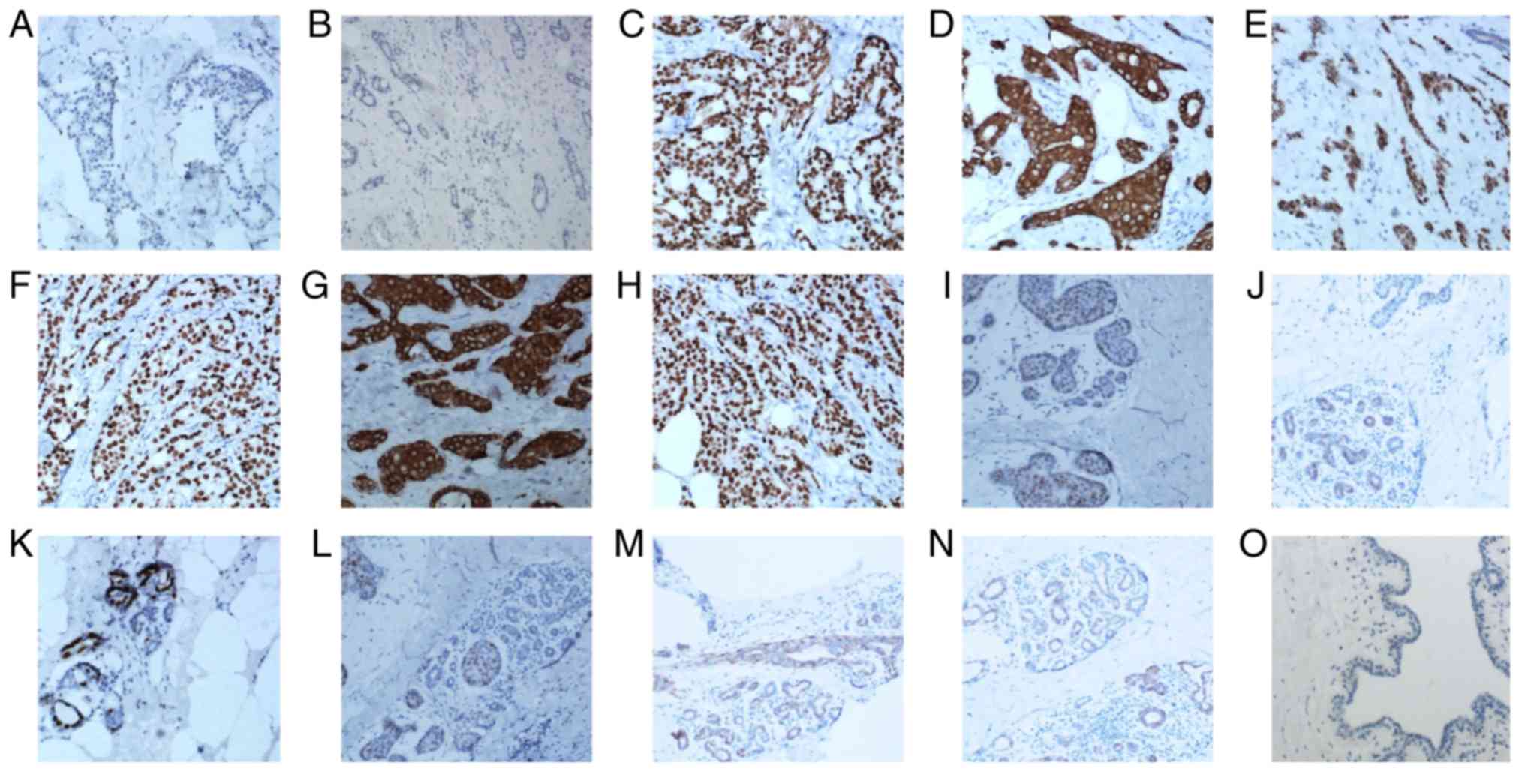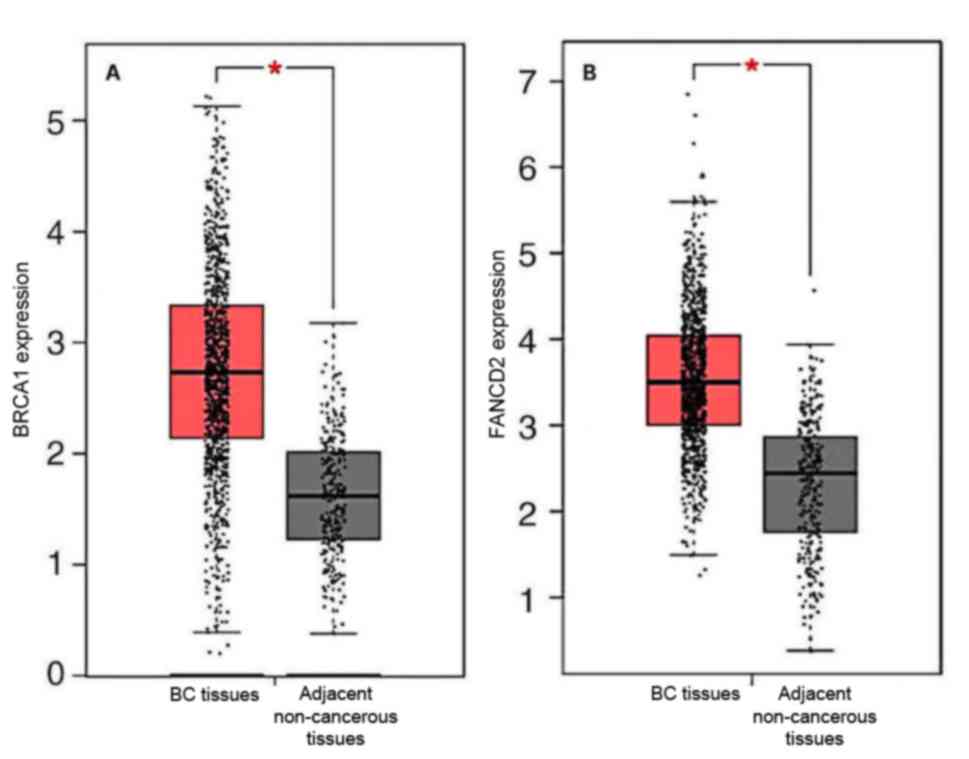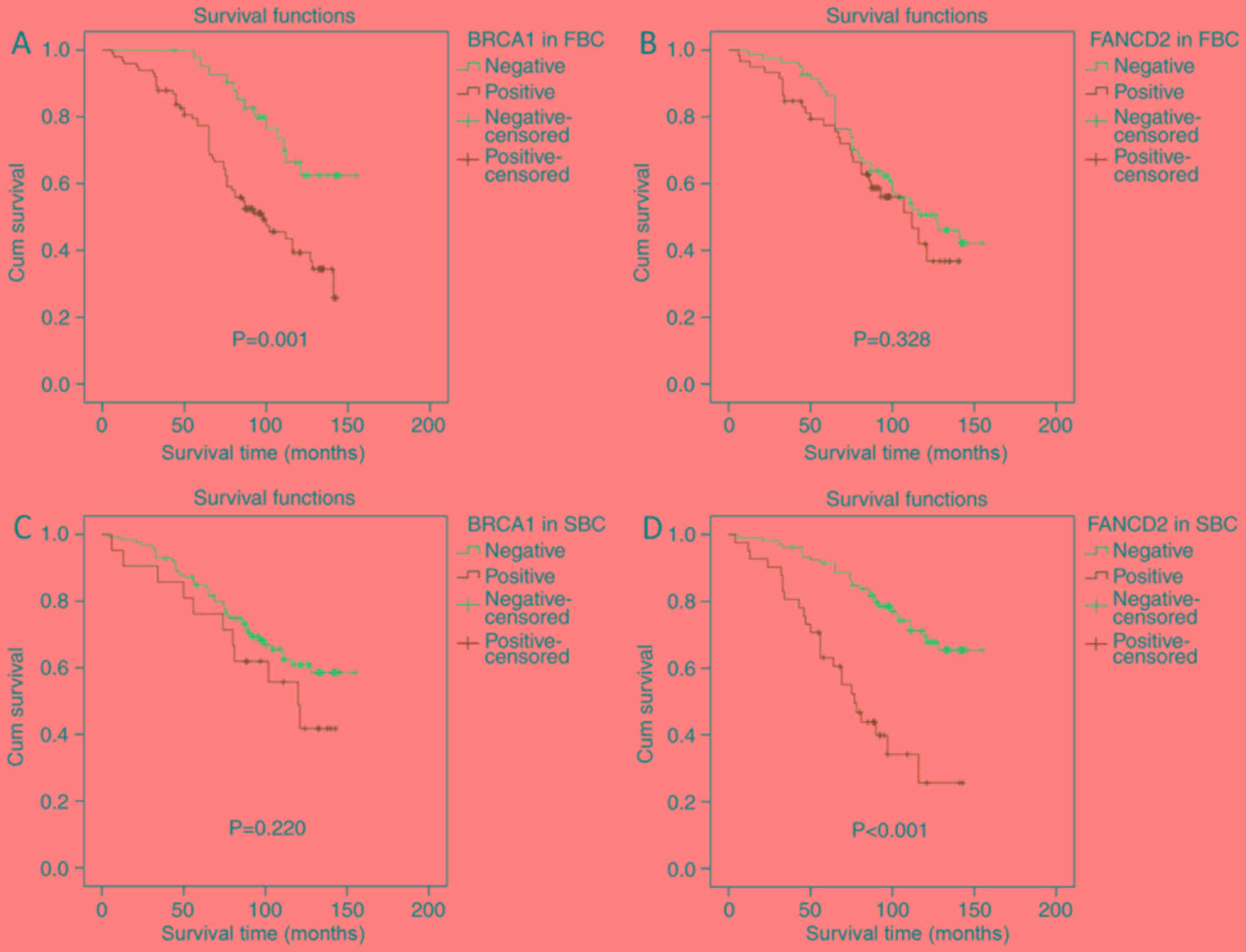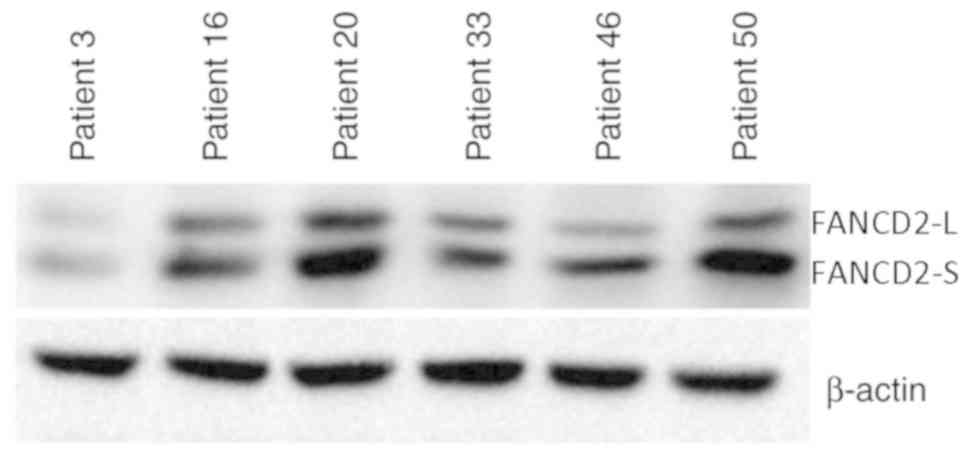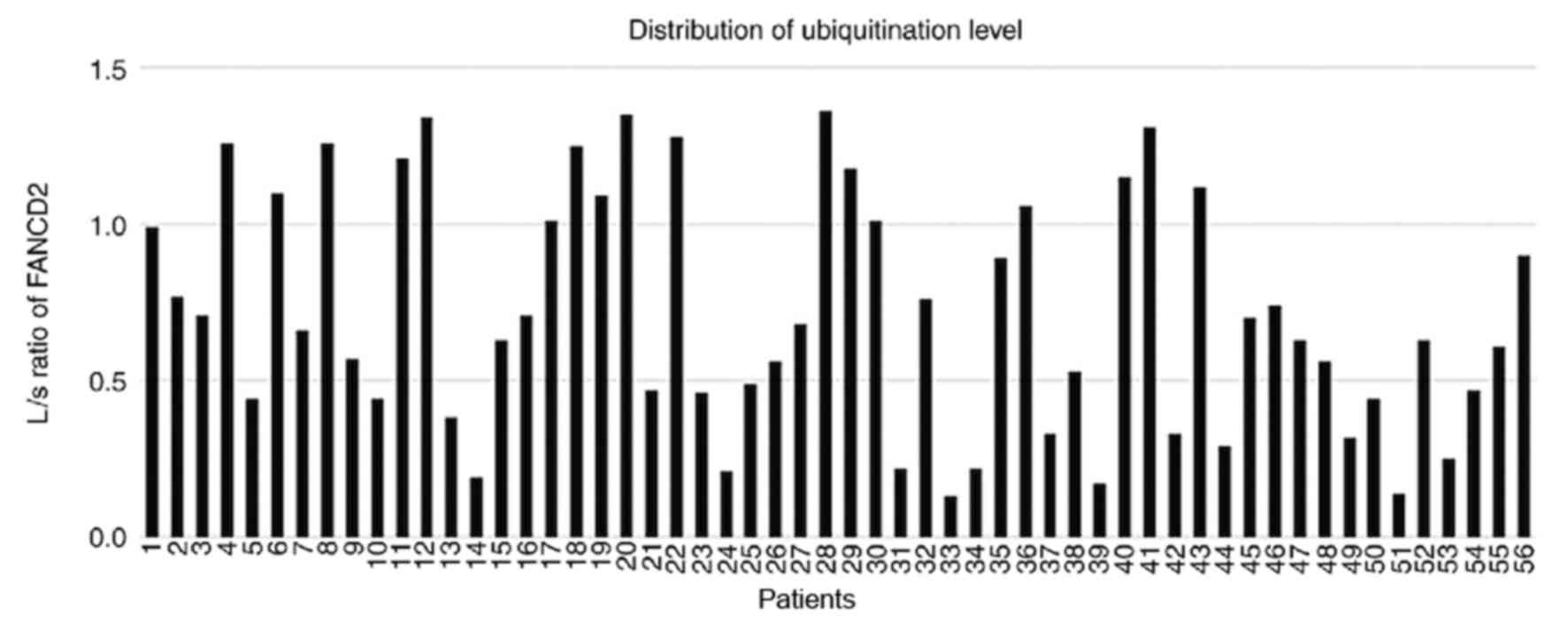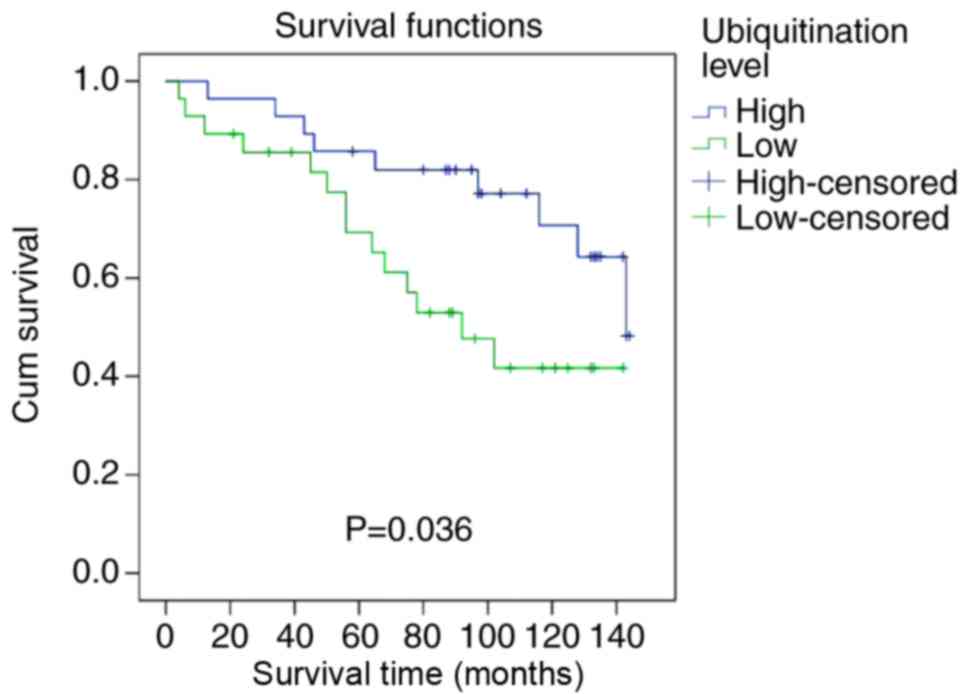|
1
|
Wendt C, Lindblom A, Arver B, von
Wachenfeldt A and Margolin S: Tumour spectrum in non-brca
hereditary breast cancer families in sweden. Hered Cancer Clin
Pract. 13:152015. View Article : Google Scholar : PubMed/NCBI
|
|
2
|
Stratton MR and Rahman N: The emerging
landscape of breast cancer susceptibility. Nat Genet. 40:17–22.
2008. View Article : Google Scholar : PubMed/NCBI
|
|
3
|
Rebbeck TR, Mitra N, Wan F, Sinilnikova
OM, Healey S, McGuffog L, Mazoyer S, Chenevix-Trench G, Easton DF,
Antoniou AC, et al: Association of type and location of BRCA1 and
BRCA2 mutations with risk of breast and ovarian cancer. JAMA.
313:1347–1361. 2015. View Article : Google Scholar : PubMed/NCBI
|
|
4
|
Bhattacharjee S and Nandi S: DNA damage
response and cancer therapeutics through the lens of the Fanconi
Anemia DNA repair pathway. Cell Commun Signal. 15:412017.
View Article : Google Scholar : PubMed/NCBI
|
|
5
|
Dong H, Nebert DW, Bruford EA, Thompson
DC, Joenje H and Vasiliou V: Update of the human and mouse Fanconi
anemia genes. Hum Genomics. 9:322015. View Article : Google Scholar : PubMed/NCBI
|
|
6
|
Garcia-Higuera I, Taniguchi T, Ganesan S,
Meyn MS, Timmers C, Hejna J, Grompe M and D'Andrea AD: Interaction
of the Fanconi anemia proteins and BRCA1 in a common pathway. Mol
Cell. 7:249–262. 2001. View Article : Google Scholar : PubMed/NCBI
|
|
7
|
Smogorzewska A, Matsuoka S, Vinciguerra P,
McDonald ER III, Hurov KE, Luo J, Ballif BA, Gygi SP, Hofmann K,
D'Andrea AD and Elledge SJ: Identification of the FANCI protein, a
monoubiquitinated FANCD2 paralog required for DNA repair. Cell.
129:289–301. 2007. View Article : Google Scholar : PubMed/NCBI
|
|
8
|
Kee Y and D'Andrea AD: Molecular
pathogenesis and clinical management of Fanconi anemia. J Clin
Invest. 122:3799–3806. 2012. View
Article : Google Scholar : PubMed/NCBI
|
|
9
|
Timmers C, Taniguchi T, Hejna J, Reifsteck
C, Lucas L, Bruun D, Thayer M, Cox B, Olson S, D'Andrea AD, et al:
Positional cloning of a novel Fanconi anemia gene, FANCD2. Mol
Cell. 7:241–248. 2001. View Article : Google Scholar : PubMed/NCBI
|
|
10
|
Zhu J, Su F, Mukherjee S, Mori E, Hu B and
Asaithamby A: FANCD2 influences replication fork processes and
genome stability in response to clustered DSBs. Cell Cycle.
14:1809–1822. 2015. View Article : Google Scholar : PubMed/NCBI
|
|
11
|
Crossan GP and Patel KJ: The Fanconi
anaemia pathway orchestrates incisions at sites of crosslinked DNA.
J Pathol. 226:326–337. 2012. View Article : Google Scholar : PubMed/NCBI
|
|
12
|
Bunting SF and Nussenzweig A: Dangerous
liaisons: Fanconi anemia and toxic nonhomologous end joining in DNA
crosslink repair. Mol Cell. 39:164–166. 2010. View Article : Google Scholar : PubMed/NCBI
|
|
13
|
Schlacher K, Wu H and Jasin M: A distinct
replication fork protection pathway connects Fanconi anemia tumor
suppressors to RAD51-BRCA1/2. Cancer Cell. 22:106–116. 2012.
View Article : Google Scholar : PubMed/NCBI
|
|
14
|
Ali AM, Pradhan A, Singh TR, Du C, Li J,
Wahengbam K, Grassman E, Auerbach AD, Pang Q and Meetei AR: FAAP20:
A novel ubiquitin-binding FA nuclear core-complex protein required
for functional integrity of the FA-BRCA DNA repair pathway. Blood.
119:3285–3294. 2012. View Article : Google Scholar : PubMed/NCBI
|
|
15
|
Domchek SM, Tang J, Stopfer J, Lilli DR,
Hamel N, Tischkowitz M, Monteiro AN, Messick TE, Powers J, Yonker
A, et al: Biallelic deleterious BRCA1 mutations in a woman with
early-onset ovarian cancer. Cancer Discov. 3:399–405. 2013.
View Article : Google Scholar : PubMed/NCBI
|
|
16
|
Gradishar WJ, Anderson BO, Balassanian R,
Blair SL, Burstein HJ, Cyr A, Elias AD, Farrar WB, Forero A,
Giordano SH, et al: NCCN guidelines insights: Breast cancer,
version 1.2017. J Natl Compr Canc Netw. 15:433–451. 2017.
View Article : Google Scholar : PubMed/NCBI
|
|
17
|
Wen T, Wang Z, Li Y, Che X, Fan Y, Wang S,
Qu J, Yang X, Hou K, Zhou W, et al: A four-factor immunoscore
system that predicts clinical outcome for stage II/III gastric
cancer. Cancer Immunol Res. 5:524–534. 2017. View Article : Google Scholar : PubMed/NCBI
|
|
18
|
Madjd Z, Karimi A, Molanae S and
Asadi-Lari M: BRCA1 protein expression level and CD44(+)phenotype
in breast cancer patients. Cell J. 13:155–162. 2011.PubMed/NCBI
|
|
19
|
Rudland PS, Platt-Higgins AM, Davies LM,
de Silva Rudland S, Wilson JB, Aladwani A, Winstanley JH,
Barraclough DL, Barraclough R, West CR and Jones NJ: Significance
of the Fanconi anemia FANCD2 protein in sporadic and metastatic
human breast cancer. Am J Pathol. 176:2935–2947. 2010. View Article : Google Scholar : PubMed/NCBI
|
|
20
|
Ling C, Ishiai M, Ali AM, Medhurst AL,
Neveling K, Kalb R, Yan Z, Xue Y, Oostra AB, Auerbach AD, et al:
FAAP100 is essential for activation of the Fanconi
anemia-associated DNA damage response pathway. EMBO J.
26:2104–2114. 2007. View Article : Google Scholar : PubMed/NCBI
|
|
21
|
Virts EL, Jankowska A, Mackay C, Glaas MF,
Wiek C, Kelich SL, Lottmann N, Kennedy FM, Marchal C, Lehnert E, et
al: AluY-mediated germline deletion, duplication and somatic stem
cell reversion in UBE2T defines a new subtype of Fanconi anemia.
Hum Mol Genet. 24:5093–5108. 2015. View Article : Google Scholar : PubMed/NCBI
|
|
22
|
Huang Z, Duan H and Li H: Identification
of gene expression pattern related to breast cancer survival using
integrated TCGA datasets and genomic tools. Biomed Res Int.
2015:8785462015. View Article : Google Scholar : PubMed/NCBI
|
|
23
|
Tang Z, Li C, Kang B, Gao G, Li C and
Zhang Z: GEPIA: A web server for cancer and normal gene expression
profiling and interactive analyses. Nucleic Acids Res. 45:W98–W102.
2017. View Article : Google Scholar : PubMed/NCBI
|
|
24
|
Chavez-MacGregor M, Mittendorf EA, Clarke
CA, Lichtensztajn DY, Hunt KK and Giordano SH: Incorporating tumor
characteristics to the American Joint Committee on cancer breast
cancer staging system. Oncologist. 22:1292–1300. 2017. View Article : Google Scholar : PubMed/NCBI
|
|
25
|
Collaborative Group on Hormonal Factors in
Breast Cancer, . Familial breast cancer: Collaborative reanalysis
of individual data from 52 epidemiological studies including 58209
women with breast cancer and 101986 women without the disease.
Lancet. 358:1389–1399. 2001. View Article : Google Scholar : PubMed/NCBI
|
|
26
|
Tazzite A, Jouhadi H, Saiss K, Benider A
and Nadifi S: Relationship between family history of breast cancer
and clinicopathological features in Moroccan patients. Ethiop J
Health Sci. 23:150–157. 2013.PubMed/NCBI
|
|
27
|
Aleskandarany M, Caracappa D, Nolan CC,
Macmillan RD, Ellis IO, Rakha EA and Green AR: DNA damage response
markers are differentially expressed in BRCA-mutated breast
cancers. Breast Cancer Res Treat. 150:81–90. 2015. View Article : Google Scholar : PubMed/NCBI
|
|
28
|
Troudi W, Uhrhammer N, Ben Romdhane K,
Sibille C, Mahfoudh W, Chouchane L, Ben Ayed F, Bignon YJ and Ben
Ammar Elgaaied A: Immunolocalization of BRCA1 protein in tumor
breast tissue: Prescreening of BRCA1 mutation in Tunisian patients
with hereditary breast cancer? Eur J Histochem. 51:219–226.
2007.PubMed/NCBI
|
|
29
|
Sun X, Gong Y, Rao MS and Badve S: Loss of
BRCA1 expression in sporadic male breast carcinoma. Breast Cancer
Res Treat. 71:1–7. 2002. View Article : Google Scholar : PubMed/NCBI
|
|
30
|
Kenemans P, Verstraeten RA and Verheijen
RH: Oncogenic pathways in hereditary and sporadic breast cancer.
Maturitas. 49:141–150. 2008. View Article : Google Scholar
|
|
31
|
Russo A, Herd-Smith A, Gestri D, Bianchi
S, Vezzosi V, Rosselli Del Turco M and Cardona G: Does family
history influence survival in breast cancer cases? Int J Cancer.
99:427–430. 2002. View Article : Google Scholar : PubMed/NCBI
|
|
32
|
Tsuchiya A, Kanno M, Nomizu T, Hatakeyama
Y, Kimijima I and Abe R: Clinical characteristics of breast cancer
patients with family history. Fukushima J Med Sci. 44:35–41.
1998.PubMed/NCBI
|
|
33
|
Esteller M, Silva JM, Dominguez G, Bonilla
F, Matias-Guiu X, Lerma E, Bussaglia E, Prat J, Harkes IC, Repasky
EA, et al: Promoter hypermethylation and BRCA1 inactivation in
sporadic breast and ovarian tumors. J Natl Cancer Inst. 92:564–569.
2000. View Article : Google Scholar : PubMed/NCBI
|
|
34
|
Walsh T, Casadei S, Coats KH, Swisher E,
Stray SM, Higgins J, Roach KC, Mandell J, Lee MK, Ciernikova S, et
al: Spectrum of mutations in BRCA1, BRCA2, CHEK2, and TP53 in
families at high risk of breast cancer. JAMA. 295:1379–1388. 2006.
View Article : Google Scholar : PubMed/NCBI
|
|
35
|
Scully R and Livingston DM: In search of
the tumour-suppressor functions of BRCA1 and BRCA2. Nature.
408:429–432. 2000. View Article : Google Scholar : PubMed/NCBI
|
|
36
|
Sakaguchi C, Morishita T, Shinagawa H and
Hishida T: Essential and distinct roles of the F-box and helicase
domains of Fbh1 in DNA damage repair. BMC Mol Biol. 9:272008.
View Article : Google Scholar : PubMed/NCBI
|
|
37
|
Lyakhovich A and Surralles J: FANCD2
depletion sensitizes cancer cells repopulation ability in vitro.
Cancer Lett. 256:186–195. 2007. View Article : Google Scholar : PubMed/NCBI
|
|
38
|
Wysham WZ, Mhawech-Fauceglia P, Li H, Hays
L, Syriac S, Skrepnik T, Wright J, Pande N, Hoatlin M and Pejovic
T: BRCAness profile of sporadic ovarian cancer predicts disease
recurrence. PLoS One. 7:e300422012. View Article : Google Scholar : PubMed/NCBI
|
|
39
|
van der Groep P, Hoelzel M, Buerger H,
Joenje H, de Winter JP and van Diest PJ: Loss of expression of
FANCD2 protein in sporadic and hereditary breast cancer. Breast
Cancer Res Treat. 107:41–47. 2008. View Article : Google Scholar
|
|
40
|
Hölzel M, van Diest PJ, Bier P, Wallisch
M, Hoatlin ME, Joenje H and de Winter JP: FANCD2 protein is
expressed in proliferating cells of human tissues that are cancer
prone in Fanconi anaemia. J Pathol. 201:198–203. 2003. View Article : Google Scholar : PubMed/NCBI
|
|
41
|
Zhang B, Chen R, Lu J, Shi Q, Zhang X and
Chen J: Expression of FANCD2 in sporadic breast cancer and
clinicopathological analysis. J Huazhong Univ Sci Technolog Med
Sci. 30:322–325. 2010. View Article : Google Scholar : PubMed/NCBI
|
|
42
|
Fagerholm R, Sprott K, Heikkinen T,
Bartkova J, Heikkilä P, Aittomäki K, Bartek J, Weaver D, Blomqvist
C and Nevanlinna H: Overabundant FANCD2, alone and combined with
NQO1, is a sensitive marker of adverse prognosis in breast cancer.
Ann Oncol. 24:2780–2785. 2013. View Article : Google Scholar : PubMed/NCBI
|
|
43
|
Pejovic T, Yates JE, Liu HY, Hays LE,
Akkari Y, Torimaru Y, Keeble W, Rathbun RK, Rodgers WH, Bale AE, et
al: Cytogenetic instability in ovarian epithelial cells from women
at risk of ovarian cancer. Cancer Res. 66:9017–9025. 2006.
View Article : Google Scholar : PubMed/NCBI
|
|
44
|
Vandenberg CJ, Gergely F, Ong CY, Pace P,
Mallery DL, Hiom K and Patel KJ: BRCA1-independent ubiquitination
of FANCD2. Mol Cell. 12:247–254. 2003. View Article : Google Scholar : PubMed/NCBI
|
|
45
|
Montes de Oca R, Andreassen PR, Margossian
SP, Gregory RC, Taniguchi T, Wang X, Houghtaling S, Grompe M and
D'Andrea AD: Regulated interaction of the Fanconi anemia protein,
FANCD2, with chromatin. Blood. 105:1003–1009. 2005. View Article : Google Scholar : PubMed/NCBI
|
|
46
|
Park WH, Margossian S, Horwitz AA, Simons
AM, D'Andrea AD and Parvin JD: Direct DNA binding activity of the
Fanconi anemia D2 protein. J Biol Chem. 280:23593–23598. 2005.
View Article : Google Scholar : PubMed/NCBI
|
|
47
|
Hussain S, Wilson JB, Medhurst AL, Hejna
J, Witt E, Ananth S, Davies A, Masson JY, Moses R, West SC, et al:
Direct interaction of FANCD2 with BRCA2 in DNA damage response
pathways. Hum Mol Genet. 13:1241–1248. 2004. View Article : Google Scholar : PubMed/NCBI
|
|
48
|
Taniguchi T, Garcia-Higuera I, Andreassen
PR, Gregory RC, Grompe M and D'Andrea AD: S-phase-specific
interaction of the Fanconi anemia protein, FANCD2, with BRCA1 and
RAD51. Blood. 100:2414–2420. 2002. View Article : Google Scholar : PubMed/NCBI
|
|
49
|
Rothfuss A and Grompe M: Repair kinetics
of genomic interstrand DNA cross-links: Evidence for DNA
double-strand break-dependent activation of the Fanconi anemia/BRCA
pathway. Mol Cell Biol. 24:123–134. 2004. View Article : Google Scholar : PubMed/NCBI
|
|
50
|
Wang W: Emergence of a DNA-damage response
network consisting of Fanconi anaemia and BRCA proteins. Nat Rev
Genet. 8:735–748. 2007. View Article : Google Scholar : PubMed/NCBI
|
|
51
|
Kais Z, Rondinelli B, Holmes A, O'Leary C,
Kozono D, D'Andrea AD and Ceccaldi R: FANCD2 maintains fork
stability in BRCA1/2-deficient tumors and promotes alternative
end-joining DNA repair. Cell Rep. 15:2488–2499. 2016. View Article : Google Scholar : PubMed/NCBI
|
|
52
|
Li Y, Zhao L, Sun H, Yu J, Li N, Liang J,
Wang Y, He M, Bai X, Yu Z, et al: Gene silencing of FANCF
potentiates the sensitivity to mitoxantrone through activation of
JNK and p38 signal pathways in breast cancer cells. PLoS One.
7:e442542012. View Article : Google Scholar : PubMed/NCBI
|
|
53
|
Barroso E, Milne RL, Fernández LP, Zamora
P, Arias JI, Benítez J and Ribas G: FANCD2 associated with sporadic
breast cancer risk. Carcinogenesis. 27:1930–1937. 2006. View Article : Google Scholar : PubMed/NCBI
|
|
54
|
Wu W, Koike A, Takeshita T and Ohta T: The
ubiquitin E3 ligase activity of BRCA1 and its biological functions.
Cell Div. 3:12008. View Article : Google Scholar : PubMed/NCBI
|















